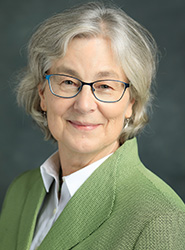
Professor
405 McClung Tower
Phone: (865) 974-6954
Fax: (865) 974-6926
lhowes@utk.edu
Biography
The second edition of Marie Borroff’s Sir Gawain and the Green Knight, edited by Professor Howes, is out in the Norton Critical Edition series, with four new critical essays, an updated introduction and selected bibliography.
Professor Howes’ area of specialization is Middle English literature, and her current book project focuses on the representation of place and space in Middle English texts. Trekking the Medieval Landscape uses The Book of Margery Kempe, Mandeville’s Travels, Sir Gawain and the Green Knight, the Canterbury Tales and other works to investigate how medieval authors conceived of and represented the spaces their characters inhabit and traverse, how movement and stasis create meaning. A subsidiary interest in the history of gardens and landscape studies also informs her research, evident in articles in The Chaucer Review and Studies in Philology.
Professor Howes regularly teaches graduate and undergraduate classes in Chaucer, medieval literature, and medieval and Renaissance women writers.
Education
- B.A., Cornell University
- M.A., Ph.D., Columbia University
Publications
- Ed., with Marie Borroff, Sir Gawain and the Green Knight: A Norton Critical Edition, 2nd edition (NY: Norton, 2022).
- Ed., Place, Space, and Landscape in Medieval Narrative. Tennessee Studies in Literature, vol. 43 (Knoxville: UT Press, 2007).
- Chaucer’s Gardens and the Language of Convention (Gainesville: University Press of Florida, 1997).
Representative articles
- “Teaching the Language of Pearl.” Approaches to Teaching the Middle English Pearl. Ed. Jane Beal and Mark Bradshaw Busbee. (NY: MLA, 2018), 66-71.
- “Chaucer’s Forests, Parks, and Groves.” The Chaucer Review 49.1 (2014):125-33.
- “Use and Reception” [of Medieval Gardens]. A Cultural History of Gardens: In the Medieval Age. Vol. 2. Ed. Michael Leslie. London: Bloomsbury, 2013. 75-100.
- “Romancing the City: Margery Kempe in Rome.” Studies in Philology 111.4 (2014): 680-90.
- “Inglewood Forest in Two Middle English Romances.” Neophilologus 97.1 (2013): 185-89.
- “‘Reducing into English’: Translation as Alchemy in the Prologues and Epilogues of William Caxton.” With Sarah McCollum. Notes and Queries 255.3 (2010): 321-25.
- “Chaucer’s Criseyde: The Betrayer Betrayed,” Reading Medieval Culture: Essays in Honor of Robert W. Hanning, ed. S.P. Prior and R. Stein (Notre Dame: University of Notre Dame Press, 2005), pp. 324-43.
- “’The Slow Curve of the Footwalker’: Narrative Time and Literary Landscapes in Middle English Poetry.” Soundings: An Interdiscplinary Journal 83.1 (2000): 165-81; rpt. In Inventing Medieval Landscapes: Senses of Place in Western Europe, ed. John Howe and Michael Wolfe (Gainesville: University Press of Flordida, 2002), pp. 192-207.
- “Theophany in the ‘Miller’s Tale’” (with Frederick M. Biggs), Medium AEvum LXV (1996), 269-79
- “Cultured Nature in Chaucer’s Early Dream-Poems,” Medieval View of Nature, ed. Joyce E. Salisbury (Garland Press, 1993), 187-200
- “On the Birth of Margery Kempe’s Last Child,” Modern Philology 90.2 (November 1992), 220-25.
